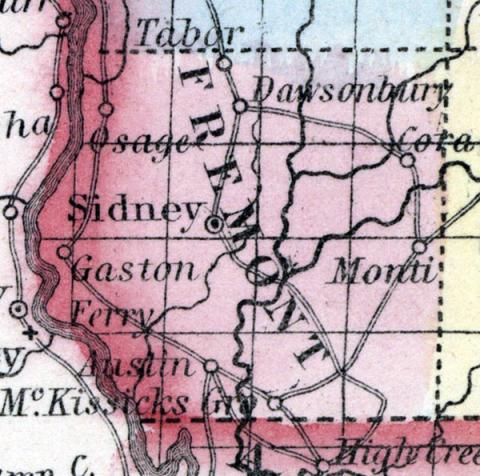FREMONT COUNTY Is the extreme south-western county of the State. The first settlement was at Sidney, the county-seat, where the first sale of lots was made June 30th, 1851. James H. Cowles was the first resident. The present population of the county-seat is 300 — that of the county 3200.
Of churches it has a Congregational, which will compare with any other in any county of like age. The Methodist Church numbers more members than any other; the Baptist next; the Christians or Campbellites are also quite numerous. The O. S. Presbyterians are preparing to organize a Church, and to erect a seminary — not, however, as a religious institution — peculiar to that body. Of public schools there are in the county some twenty, with ample room for improvement in a majority of them.Here are a carding-machine and two grist-mills, one steam saw-mill, and four water-power saw-mills, all doing an excellent business. Also two portable, six-horse-power saw-mills, four stores, one saddler, one shoemaker, two tailors, four blacksmiths, one gunsmith — no newspaper, but a reading, intelligent people. We are in great need of more manufactories and mechanics. A steam flouring-mill would do a first-rate business. The surrounding country is well adapted to all kinds of agricultural pursuits, possessing a rich and productive soil, well supplied with water and timber, and rapidly settling up with worthy, industrious and intelligent people. (Iowa As It Is in 1855; A Gazetteer for Citizens..., 1855)
FREMONT COUNTY Is bounded on the north by Mills county, on the west by the Missouri River, on the south by the State of Missouri, and on the east by Page county.
It was organized in 1850. About ten miles of the southern portion of the county was once under the jurisdiction of the State of Missouri, until the boundary was finally established between the two States.
The first settlements were made in the southern part of the county, including McKissick's Grove, Pleasant Grove, etc. The next settlement was made northwest of where Sidney now stands, in Lacy's Grove. Among the first settlers in the county, were Jacob McKissick, Cornelius McKissick, Daniel Huntsucker, Isaac Huntsucker, J. J. Singleton, George Lacy, Thomas Greenwood and John Leaky.
The general surface of the county is undulating, but not broken; but there is a great deal of it which is quite level.
The soil is very productive, and is well adapted for growing all kinds of small grains, maize, the different kinds of tame grasses, and red clover. All kinds of fruit do well here apples and pears, cherries, grapes, etc. The county is well adapted to rearing all kinds of stock—wild grasses abundantly abound. The county is about two-thirds prairie, the balance is timber. The timber is mostly in the southern, central and western parts of the county. There are large groves, however, in the eastern and northeastern parts. In the western part, near the Missouri River, the timber consists of cotton-wood, hackberry, mulberry and sycamore. In the central part, are the different kinds of oak, hickory, walnut, hackberry, coffeebean, bass and elm ; and in the eastern, oak and red hickory, with a few other varieties. In the northwestern part, there is an almost inexhaustible quarry of building stone. Brick of a superior quality has been, and is now being made in Fremont. The two main streams of water running through the county, are the Nishnabotany Rivers. The course of the West Nishnabotany is, from where it enters the county on the north, directly south. The course of the other branch is from northeast to southwest, until it empties into West Nishnabotany. Besides these two, there are Mill Creek, Otter Creek, Walnut Creek, Deer Creek, Camp Creek, Plum Creek and numerous others of less magnitude. Upon several of these streams there are good grist and sawmills running nearly the whole year. Besides the mill sites now occupied and used, there are many other good situations on these streams, well adapted for the purpose of propelling machinery. There is now in process of erection upon one of the streams, a woolen factory, where carding, spinning and weaving will be carried on. Fremont County is one of the most handsome, fertile and flourishing counties in the West. It now has a population of about 8000, and is destined, in a few years, when the St. Joseph & Council Bluffs Railroad, which is now under contract, shall be completed, to quadruple in population. (Hair's Iowa State Gazetteer...,1865)

